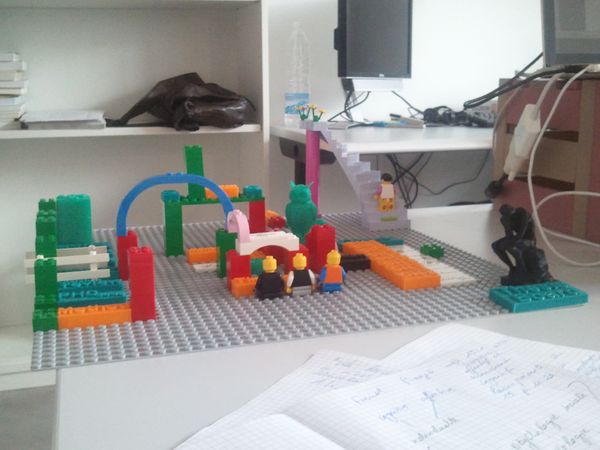Using a thesis project board
Introduction
Thesis project boards are physical visualization tools that help folks with both planning and monitoring a Master or PHD thesis. They also are social tools: Being on display in an office or a living room, a project board will show others "where your are".
Project boards can be created with any sort of materials, e.g. a whiteboard or wall plus PostIts. In this article we will focus on boards made with Legos and that is described in the Lego-compatible thesis project board article
This experience has been conducted in 2012/2013 and may be renewed in the future. Currently, the purpose of this wiki page was twofold:
- Track the evolution of pilot user's appropriation of the concept
- Write down ideas, etc.
The concept has been presented as a poster [1] at EIAH '2015
User testing
In November 2012, we started involving PhD students in the project.
User 1
Subject: PhD student in an earlier stage of thesis (project accepted by thesis commission)
User 1 went through several stages. Below we just summarize some elements:
Stages (so far, nov 2012 to March 2013)
- Used the project board
- Used a bigger standard Lego board in order to regroup, add extra handwritten bricks, add progress stairs.
- Use a still bigger standard Lego board in order to create connections, add "stories", etc.
- Destroyed the structure
- Designed visualization that focuses on a small set of essential current elements she is working on.
We define stage as a major shift. Within each stage, there have been variations that are just documented with pictures.
Stage 2
- nov 19 2012
- Includes labeling of chapters
- Adds a general progress indicator (stairs brought in from home)
- Identifies more issues
- Adds "play" bricks
- Two other PHD students want one
Stage 3
- nov 22 2012
- Adds connectors (the arcs) visualizing how a task and an issue and 2 issues are connected
- Uses extra bricks (e.g. a gate-in)
- Adds persona (thesis advisor, kids, ...)
- Identifies yet more issues
- Layout is often changed/updated (sometimes several times per day)
Stage 3b
- This layout starts attracting other users for play. On 11/29 a colleague moved up the persona on the stairs.
Stage 4
January 8, 2013.
In the cloud. User feels that the project doesn't advance enough.
In addition, there is some focus on essential issues:
Stage 5
February, 2013
User 2
Subject: PhD student in an earlier stage of thesis (project accepted by thesis commission). Some literature review and development done.
User 2 shares office with user 1 and immediately wanted to work with a large board.
Stage 1
Nov 23 2012.
- Separated issues into two different kinds (these related and external/others)
- Associated chapter bricks with task bricks
The following pictures show a prototype after a few minutes into the "game"
Stage 2
8 January 2013
User 2 associated types of bricks next to each other and also added other artifacts
Stage 3
On february 2013, the same type of layout was used. Changes:
- A new visualisation of some kind of pilot using handles
- A broken link (pink arc that doesn't connect)
- Some progress meters going up
User 3
User three (on a short visit, from a different institution) was shown the boards from use 1 and 2, liked the idea. Since we didn't print any special purpose bricks, he only given standard Lego pieces:
- A medium-sized base plate
- 3x3 tiles
- 4x2 tiles
- 2x2 tiles
- 2x2 tiles with a question mark
His PHD project includes the design of a collaborative "knowledge tool", i.e. some kind of applied computer science, the kind that can be done in an interdisciplinary research lab....
Phase 1
Feb 26 2013 (about one week later)

Bibliography
- ↑ Schneider, Daniel, K. (2015). Visualisation de projets de thèse avec un dispositif physique et constructif. Actes de la conférence EIAH 2015, Agadir, Maroc. Preprint: http://tecfa.unige.ch/tecfa/talks/schneide/eiah-2015/Schneider_EIAH2015-lego-final.pdf
- Denio, Donna and Dieter Reuther (2016). Build to Lead, How Lego Bricks Can Make You a Better Leader, O'Reilly. Available online (free). http://www.oreilly.com/business/free/build-to-lead.csp
- Schneider, Daniel, K. (2015). Visualisation de projets de thèse avec un dispositif physique et constructif. Actes de la conférence EIAH 2015, Agadir, Maroc.











